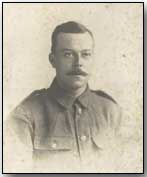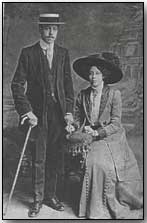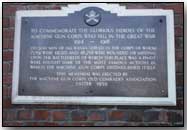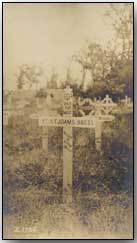Feature Articles - Finding Private Adams
 In late 1917, a young
mother and the wife of a serviceman received the telegram that she had been
dreading. Her husband had fallen on the Western Front.
In late 1917, a young
mother and the wife of a serviceman received the telegram that she had been
dreading. Her husband had fallen on the Western Front.
Grieving and shocked she writes to her husband's commanding officer asking for the return of his possessions and for further news on his death and final resting place.
The story above was replayed time and time again during the First World War - but in this case, the young woman was my great grandmother. For the military machine the death of a soldier had, by 1917, become a matter of routine - a case of dotting the i's and crossing the t's. For the family members, the violent death of a loved one was to haunt them for years to come.
I had decided, as a present for my grandfather, to try and retrace and reconstruct the war career of the father he had known only as a baby. My parents had found Private Alfred Thomas Adams' grave a decade ago. His final resting place was in the military cemetery of Roclincourt. The commanding officer's letter of reply to my great grandmother also proved invaluable. He had signed the letter with his rank and importantly, his company - 243 Machine Gun Company. From this shred of information I could try to reconstruct my great-grandfather's army career.
I quickly discovered that 243 MG Coy was assigned to 31 Division on the Oppy/Gavrelle sector during 1917. The divisional and company diaries are to be found in the Public Record Office. The Company's diary records the death of Alfred and those who fell with him on 26/11/17. The entry is stark in its indifference: 'Situation fairly quiet, enemy artillery fairly active during afternoon few shells fell in the vicinity of TYNE BATTERY one dropping in the trench causing 7 casualties to this company i.e. 4 killed 3 wounded. One section in rest and training.'
Unfortunately the individual files held on Private Adams were destroyed (60% of soldiers' files were lost to Luftwaffe bombing in World War Two). Thus it was impossible to trace Private Adams' career prior to the July 1917 start of the Company diaries. No private correspondence of Alfred's survives which could shed light upon these 'missing' years. However, one can, through general research, make an educated guess.
This then is the possible career of my great grandfather:-
 A
successful entrepreneur and highly intelligent man, Alfred Adams ran a
number of interests from a shop in Battersea. One of his successful
outlets was importing records, a product that had gained mass appeal.
A
successful entrepreneur and highly intelligent man, Alfred Adams ran a
number of interests from a shop in Battersea. One of his successful
outlets was importing records, a product that had gained mass appeal.
But Alfred's world, like millions of others, was turned upside down when Britain declared war on Germany in August 1914. However, I do not think that he would have joined in the first waves of volunteers. The rush of men to the colours in the first months of the war was too much for the War Office to deal with - many recruits were turned away, especially the family men.
But the toll of industrialised conflict soon began to tell. It became clear that the BEF was too small and in urgent need of more reserves. Those who had been turned away in late summer were again asked to volunteer or later on, forced to join the war through a universal draft. Alfred Adams probably enlisted in the first half of 1915 as part of Kitchener's grand plan to create a civilian army built up of Pals Battalions.
Once in the Army, Alfred became a number - 98533. To begin with he faced a couple of months worth of drill, square bashing and weapons training in order to turn him from a shopkeeper to soldier. Private Adams became a fully paid up member of PBI, the Poor Bloody Infantry. His unit might have been sent to France in order to prepare for the great Somme offensives of 1916 or, if he was 'lucky', the battalion would have been sent to Flanders, a hell hole certainly, but one that offered a better chance of survival - in that year at least.
Yet Alfred, given his intelligence, was not the sort of man to remain a footslogger for long - he was highly intelligent and, having gone to Battersea Polytechnic, used to working with complicated equipment. In fact, he was the perfect sort of person to become a member of the newly created Machine Gun Corps.
No. 98533 would certainly have been sent to the Machine Gun training centre at Grantham back in Blighty. Here he would have familiarised himself with the workings and intricacies of the Vickers .303 inch heavy machine gun.
He would have become a team player - each gun was ideally manned by a crew of eight. Four men were involved in the actual firing and the other four responsible for sighting and the preparation and the bringing up of ammunition. Crews in the field normally numbered six, simply because of the shortage of men.
The Grantham course would have only lasted approximately 6 weeks due to the intense demand for gunners. Thus Alfred would have really only had basic training in the complexities of machine-gun warfare. His experience he would have to gain at the front and from the guidance of comrades.
 He would have leaned his
'trade' quickly and in the thick of the fighting - it was not for nothing
that members of the MGC were called the 'Suicide Squad'. His machine
gun would have been placed in a battery of (usually) four guns.
Alfred's battery fellows would have been the members of his 'Trench
Household' - the people who he would have day to day contact with. His
closest friends, or 'mucking in pals' he would help, protect and serve above
all else. They in turn would do the same for him.
He would have leaned his
'trade' quickly and in the thick of the fighting - it was not for nothing
that members of the MGC were called the 'Suicide Squad'. His machine
gun would have been placed in a battery of (usually) four guns.
Alfred's battery fellows would have been the members of his 'Trench
Household' - the people who he would have day to day contact with. His
closest friends, or 'mucking in pals' he would help, protect and serve above
all else. They in turn would do the same for him.
We can be sure that Private Adams was with 243 MG Coy when it was posted to the Gavrelle/Oppy under the command of 31st Division. The company arrived in France on 13 July and the Front on 18 July. On 19 July, maybe realising how dangerous the sector was, Alfred opted to draw up his will.
Life at the front was a nightmare, but more so for the average gunner. The troops could expect a more than heavy dose of incoming fire if their position was 'registered' by the enemy. If there was a lull in enemy activity Alfred would have helped out in cleaning the machine gun, a job, given the conditions, which always needed doing.
At night he would have been involved in strafing no-man's land in an effort to catch working parties in a deadly hail of lead. If they were posted to a 'Live and Let Live' sector, the crew usually fired off a couple of desultory bursts. However, on a 'Hot' section of the line the machine gun would have been fired by whipping the bullets back and forth in a curving motion and along different angles. This action would have increased the chance of killing the enemy who had ducked at the first salvo and then stood up thinking the fire had moved along - a fatal mistake.
Assuming that Alfred actually fired the gun, and bearing his musical knowledge mind, he might, if he was good, have hammered out the bursts in time to the latest popular song. Strange as it may seem, many gunners built up a repertoire, and on a number of occasions, other weapons would accompany the song creating what the troops endearingly called a machine gun orchestra! Some of these men became popular heroes on the front and were given nicknames: Duck Board Dick, Parapet Joe, Happy Harry etc.
When the infantry initiated a raid, Alfred's company, possibly along with another machine gun unit, (all depending on the size of the action) would have been involved in a support role. This they would do by firing at enemy lines, communication trenches and supply points. He was undoubtedly involved in assisting a sizable raid on 8 November as the diary records all 16 of the Company's guns were deployed.
On a raid to take and secure enemy trenches, Alfred and his crew may have drawn a short straw - they could have been ordered to race into positions once the new 'real estate' had been secured and then await for the virtually inevitable counter-attack. It was a very dangerous and vulnerable place to be in.
But Alfred was never constantly in the line - his company was relieved on a rotating basis. Again, if he was unlucky the engineers may have grabbed him and his comrades to help repair trenches and secure support lines. Usually he would have arrived in the reserve lines and stayed in comparatively safe billets. His crew men would then take part in training exercises - something the men, shattered from being at the front, would have certainly loathed.
 Alfred Adams was killed on
November 26. His Division, given the number of raids it undertook in
such a short a space of time, was an aggressive one. German artillery
was therefore constant and unpredictable. Added to this, was the
ongoing battle of Cambrai occurring to the south.
Alfred Adams was killed on
November 26. His Division, given the number of raids it undertook in
such a short a space of time, was an aggressive one. German artillery
was therefore constant and unpredictable. Added to this, was the
ongoing battle of Cambrai occurring to the south.
To stop the Germans withdrawing men and material, the British would have shelled the enemy regularly; an action that would have invited a heavy amount of counter-fire. Thus the atmosphere of the Oppy/Gavrelle area was thick with shells, bullets and shrapnel. The chances of being hit, maimed or killed were high.
But I do not believe that Alfred died from a rogue shell or a random trench mortar. The divisional diary confirms that the Germans launched a night raid in the sector that evening. We know that Alfred's gun on that day was located on the close support 'Red Line' at 'Tyne Battery'. I suspect that the Germans had registered his position and to prepare for their assault unleashed a minor barrage to disrupt, damage or destroy the gun emplacement. This then, was probably the cause that led to the consequence of Alfred's death.
Private Adams must have been well liked. Many soldiers were simply buried with a basic wooden post merely detailing their name and number. Private Adams was interred by his comrades and his grave marked by a well made and relatively ornamental cross. And although it is little consolation, Alfred was lucky that his body was recovered - thousands upon thousands of men were literally atomised by falling shells or simply swallowed up in the quagmire of no-man's land.
Contributed by Simon Rees; photographs copyright L. Adams (reproduced with permission)
"ANZAC" was coined in s1915 from the initials of the Australian and New Zealand Army Corps.
- Did you know?
